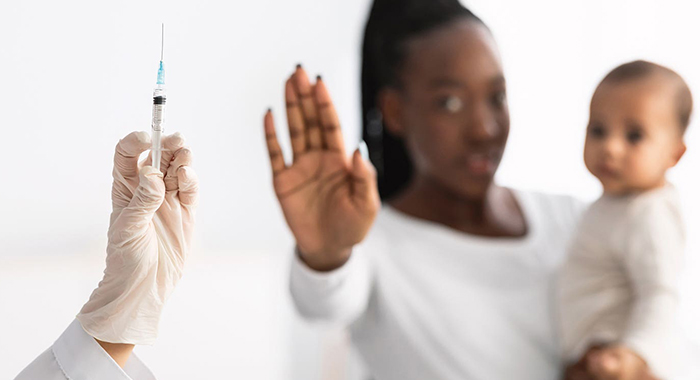Chief Medical Officer (CMO), Dr. Simone Keizer Beache recommended in 2021 “the immediate vaccination” of 70% of the population of St. Vincent and the Grenadines to achieve “herd immunity” against the COVID-19 virus.
However, Justice of Appeal Gerhard Wallbank in his dissenting judgement this month noted that the groups of Vincentians whose training helps them to recognise misinformation were among the people who persisted in refusing to take the jab.
Justice Wallbank also noted that the government admitted in court documents that it aimed to get people to take the jab.
He said this raises the question of whether the government’s campaign was also “misinformation”, as its stated aim was to convince people to take the vaccine rather than present them with balanced information.
Justice Wallbank, unlike his colleagues Justice of Appeal Eddy Ventose and Paul Webster, said he would have dismissed the government’s appeal and uphold the March 2023 ruling of High Court judge Justice Esco Henry that the mandate was unlawful.
In his dissenting judgment, Justice Wallbank noted that the government had allocated US$1,369,380 to its vaccination roll-out campaign, which included US$460,000 from external sources, including US$600,000 from an unnamed “Friendly Government Source”.
The Vaccine roll-out was accompanied by an information communication campaign, as detailed in a document called the “Saint Vincent and the Grenadines National COV-19 Vaccine Introduction and Deployment Plan”, dated Feb. 22, 2024.
Justice Wallbank said it is apparent from the plan that the government anticipated that it would be difficult to persuade members of the public to take the vaccine in the observable circumstances of COVID-19.
Moreover, the plan recounted as part of the purpose of the government’s communication plan:
“(b) to build vaccine confidence and dispel myths and rumours among the general population
“© to positively influences [sic] vaccine uptake among the target population.”
Justice Wallbank pointed out that the CMO gave evidence that her recommendation to the government was “the urgent and aggressive procurement of effective vaccines and the immediate vaccination of 70% of the population of Saint Vincent and the Grenadines’ in order to achieve ‘herd immunity’ amongst the public.
“By early June 2021, the Government’s Health Services Subcommittee recommended additional measures to overcome ‘vaccine hesitancy’.”
The CMO testified that the outcome of the information communication campaign was not as successful as the government had hoped.
“Regrettably, our efforts to improve vaccination rates in order to prevent serious illness and save lives failed. Saint Vincent and the Grenadines has one of the lowest vaccination rates in the region due to misinformation on the efficacy and safety of the vaccines and associated hesitancy.”
Justice Wallbank noted that the CMO did not specify what the “misinformation” was.
“The CMO’s attributing refusal to take the vaccine to unspecified ‘misinformation’ is ironic,” the judge said.
“The facts of the matter before the Court paradoxically present us with a situation where the two main groups of respondents who persisted in refusing to take the Vaccine comprise educated members of the population (predominantly medical doctors and other medical workers and teachers) and professionally trained critical observers (Police Officers), categories of workers one might think least likely to be swayed by ‘misinformation’,” Justice Wallbank reasoned.
He further said that the government’s “Saint Vincent and the Grenadines National COVID-19 Vaccine Introduction and Deployment Plan” was purposefully slanted “to positively influences [sic] vaccine uptake among the target population”.
Justice Wallbank commented:
“Dispassionately, one is bound to ask oneself why the Government’s narrative was not itself ‘misinformation’; since the Government’s goal was not to provide the public with a balanced, informed and informative view to assist persons in deciding for themselves whether or not to take the Vaccine, but to influence them positively to do so. Ultimately, for the CMO to have ascribed low vaccine uptake to unspecified ‘misinformation’ was easy to do but meaningless.”
The vaccination campaign plan described the strategies, and vaccination tactics to be taken for the introduction of COVID-19 vaccines.
“The policy position of the Ministry of Health, Wellness and Environment is that COVID-19 vaccinations should be voluntary rather than mandatory in the first instance,” it further stated.
The plan said the success of the vaccination with the COVID vaccines will require a strong and comprehensive risk communication programme guided by a risk communications plan which utilises gatekeepers of the various target groups.
“Teachers, church leaders, political party leaders, trade union leaders, talk radio personalities, entertainers, private and public sector HCWs must be coopted to take the message to the entire population to ensure the required vaccine acceptance and uptake,” the plan said.
It said that early and consistent messaging utilising all available media and appropriate in-person sessions would be used.
“Persons who request the vaccine even if outside the target groups should be considered as a mechanism to build positive reinforcement experiences.”
It said appropriate messages and jingles would be developed for the media providing accurate information for the target population.
“Interactive sessions, powerpoint presentations are some things that will be done to inform people about the vaccine. The capacity of the frontline workers will be built by doing presentations and providing reading materials, answer their questions about the vaccines to support their roles as recipients and vaccinators,” the plan stated.







Serious discrepancies in education, so that people will be able to discern sense from nonsense is heavily lacking in SVG. Like everybody should know that division by zero is nonsense.